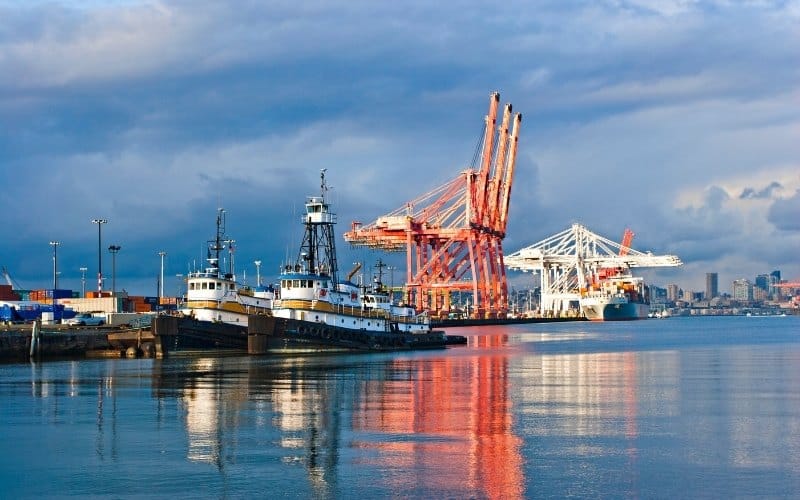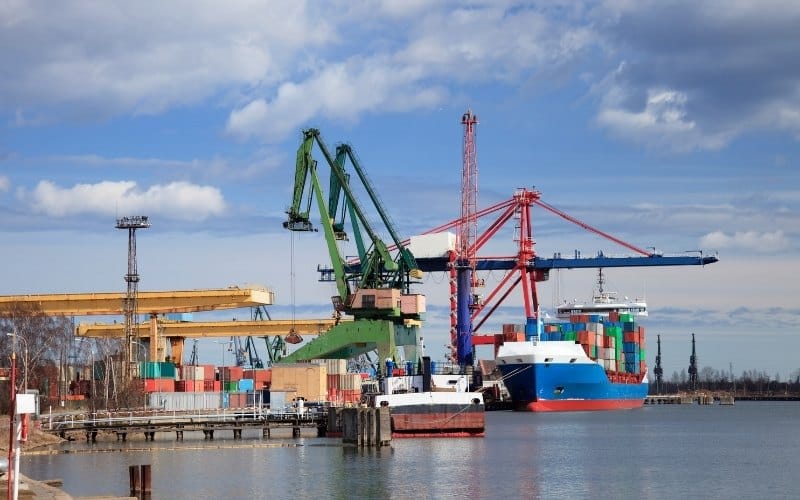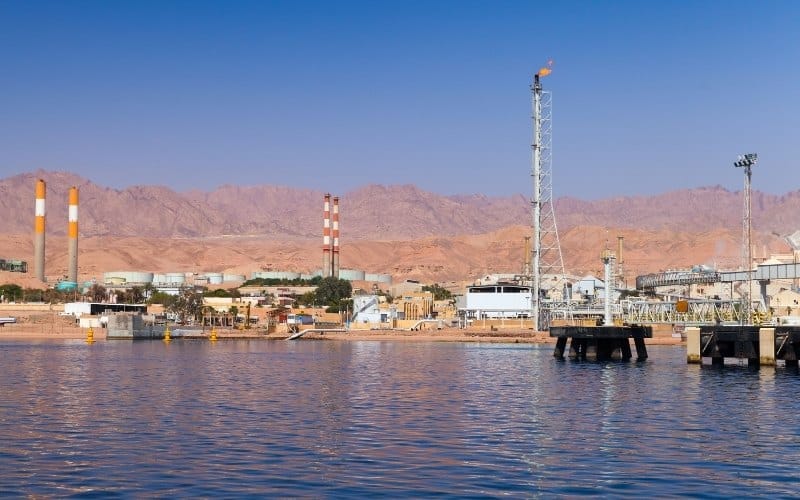What Are The Major Ports In Jordan?
The Hashemite Kingdom of Jordon is situated in West Asia and shares its borders with Saudi Arabia, Iraq, Syria, Israel and Palestine. Its 26 km long coastline runs along the Red Sea in the southwest and on its western front is the Dead sea.
Jordan is called “the oasis of stability” as it has remained untouched by the violence and turbulence of the Middle East. It is a semi-arid country and one of the smallest economies of the region. Nonetheless, it is an attractive destination for foreign investors and tourists alike.
Jordan has only one major seaport, called the Port Of Aqaba which is situated at the mouth of the Gulf of Aqaba in the Red Sea. Through the Port of Aqaba, Jordan aims to expand its trade and commerce with the world.
Aqaba is endowed with multimodal transport, logistics network and also has a famous beach and diving resort. It is an important contributor to the Jordanian economy as it is a flourishing industrial centre, exporting phosphate and shells.
The Government has invested in many projects to place the Aqaba Port at par with global port standards. Since 2000, the Aqaba Special Economic Zone was created which provided many economic opportunities to the local population. This endeavour also encouraged the growth of Aqaba as a popular tourist spot with many new resorts being built. It also attracted many shipping companies to invest in the Port of Aqaba.
Currently, the Aqaba Port comprises 12 terminals that span across 32 modern berths, operated by using the latest technology and endowed with world-class facilities. The government aims to promote maritime shipping, encourage public-private partnerships and offer quality services through the Aqaba Port. Hence, it is an important contributor to the Jordanian economy.
It serves as a transhipment port centre and is strategically located. It is located in the deep waters which give it an edge over the other ports in the region. Regular ferry services are available from Aqaba Port to the Nueib’e port in Egypt. It is also well connected by an airport, roads and railways.
The Aqaba Port Authority came into being in 1952 as a result of a royal decree. It was later named- The Ports Corporation in 1978, responsible for operating ports and their facilities. The Aqaba Port is now owned by Aqaba Development Corporation. In 2004, it was given to Aqaba Danish Management which aimed to raise Aqaba’s productivity and to transform it into a global trading hub.
The Aqaba Port has three sectors namely-The Aqaba main Terminal, The Aqaba Containers Terminal and The Aqaba Industrial Terminal.
The Aqaba Main Terminal

The main port of Aqaba is situated near the town of Aqaba. In 2006, it was shifted from the centre to the southern part of the city due to the presence of deeper waters in the south. This has increased the efficiency of the Aqaba Port.
It has 12 berths whose total length is around 2120 meters. This port handles general cargo, exports phosphate, grain, coal, live cattle and lighter vehicle traffic. These berths can deal with huge vessels with around 70-80,000 tons displacement with a draft of 14.5 meters.
All the berths have a 35 m broad apron, one transit shed, a half-covered shed and open storage spaces. Berth no.1 handles imported grain and has two ship unloaders with a capacity of 1000 tons per hour. These discharge the grains into the grain silos situated nearby.
The Phosphate Berth A is 220 meters long and is equipped with an 11 m draft and can handle vessels weighing around 25,000 tons. The Phosphate Berth B is 180 m long and has two ship loaders with a loading capacity of 2,200 tons per hour.
The main port has cranes, containers and the Aqaba Port Corporation has its fire brigade facility- three fire engines, three ambulances and two tugboats.
The Container Terminal

Aqaba Container Terminal is the driver of the Hashemite kingdom’s economic progress as it has strengthened the transport chain with its effective and internationally famous services. A 25 year Joint Development Agreement was signed between Aqaba Development Corporation and APM terminals. This is a business model built on public-private partnership and technological innovation. Due to continuous efforts by the stakeholders, the container terminal expanded to 1000 m in 2015, with an increase in its cargo capacity to 1.5 million TEUs.
The container terminal has three berths which are 540 meters long. It can receive ships weighing around 85,000 tons. This terminal has 3 gantry cranes weighing around 45 tons, two mobile harbour cranes and 376 reefer points and transfer facilities and modern equipment.
The Container Terminal is at a distance of 5 km to the south of the Main port. It consists of the Mo’ta Berth, the Moshterak Berth, Ro-Ro Berth and the Yarmouk Berth, which is a passenger terminal.
The Mo’ta Berth is a 150 m long floating berth. It is 35 m wide and is suited for vessels with a 23m draft. It can receive ships with around 54,000 tons displacement. This berth deals with livestock and is connected with the nearby rice processing unit.
The Moshterak Berth is called the dolphin berth as well. It is 120 meters long with an 11 m draft. It can handle vessels up to 100,000 displacements and has a conveyor belt with a capacity of 25 tons per hour. Usually, cement is exported from this port.
The Yarmouk Berth is similar to the Mo’ta berth. It is essentially a passenger terminal and handles light traffic including Ro-Ro ships weighing around 19,000 tons with a draft of 9 meters. The passenger terminal required further development as it received many pilgrims during the haj months. Hence, the Aqaba Development Corporation expanded and refurnished all terminal buildings, expanded the yards and also created additional yard space to be used during haj season.
The Industrial Terminal

The Aqaba industrial terminal is situated 18 m south of the main port. It has an oil jetty, a timber berth, industrial berths including the western berth and the eastern berth.
The oil jetty was built in 1986 as a 4-dolphin berth. It is 150 meters long with a 25 meters draft. It deals with oil tankers weighing around 406,000 tons. It handles exports and imports of oil and oil products. It has three inbuilt units for discharging crude oil, gas and fuel. It is also equipped with 14 crude oil loading points and also a bromide loading unit.
The timber berth is 80 meters long with a 7 meters draft. It handles livestock and timber export.
The western industrial berth is 220 meters long with 16 meters draft. It handles potash, salt, sulphur and dry bulk cargo.
The eastern industrial berth is smaller in size compared to the western one. It deals with bulk fertilizers, ammonia and chemical products.
The Aqaba Port Marine Services Company provides services such as VTS, pilotage, tugs, garbage collection and regular freshwater supply at the port.
The Aqaba Port has been the major focal point of economic development in Jordan. In the past few years, the Aqaba Port has seen much progress. A Window Berth System was established on the port. The port productivity has increased by 40%.
An Inland Logistics Port Complex has also come up. It also witnessed an increase in traffic, expansion of storage spaces, modernization of equipment and increase in container volumes. Another advantage of Aqaba port is that it is directly connected with international shipping lines.
You might also like to read:
- 5 Major Ports In Iraq
- 5 Major Ports In Guatemala
- 9 Major Ports in Kenya
- 5 Major Ports In Sudan
- 4 Major Ports In Cambodia
Disclaimer: The authors’ views expressed in this article do not necessarily reflect the views of Marine Insight. Data and charts, if used, in the article have been sourced from available information and have not been authenticated by any statutory authority. The author and Marine Insight do not claim it to be accurate nor accept any responsibility for the same. The views constitute only the opinions and do not constitute any guidelines or recommendations on any course of action to be followed by the reader.
Do you have info to share with us ? Suggest a correction
Latest Maritime Knowledge Articles You Would Like:
Subscribe To Our Newsletters
By subscribing, you agree to our Privacy Policy and may receive occasional deal communications; you can unsubscribe anytime.















